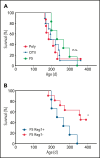Silva A, Almeida ARM, Cachucho A, et al. Overexpression of wild-type IL-7Rα promotes T-cell acute lymphoblastic leukemia/lymphoma. Blood. 2021;138(12):1040-1052
- PMID: 38753359
- PMCID: PMC11208294
- DOI: 10.1182/blood.2024024693
Silva A, Almeida ARM, Cachucho A, et al. Overexpression of wild-type IL-7Rα promotes T-cell acute lymphoblastic leukemia/lymphoma. Blood. 2021;138(12):1040-1052
Figures



Erratum for
-
Overexpression of wild-type IL-7Rα promotes T-cell acute lymphoblastic leukemia/lymphoma.Blood. 2021 Sep 23;138(12):1040-1052. doi: 10.1182/blood.2019000553. Blood. 2021. PMID: 33970999 Free PMC article.
References
Publication types
LinkOut - more resources
Full Text Sources

